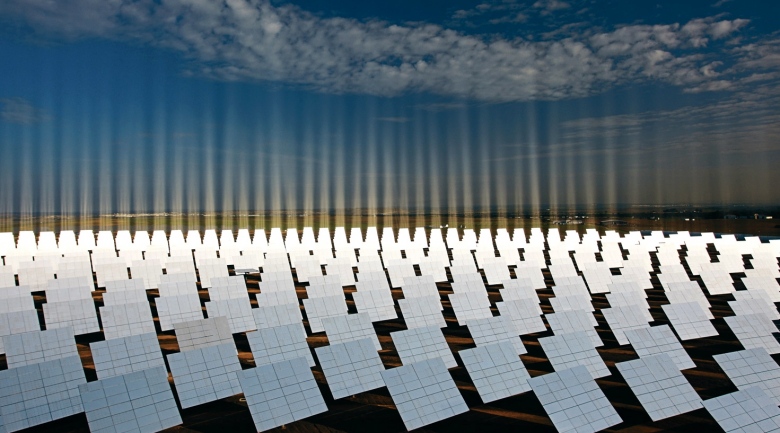
The new thermoelectronic approach promises efficiencies in the high 40-50% range, achieving the latter by acting as a “topping cycle” to a lower temperature steam system. For example a coal furnace burns at ~1500 C (1773 K), but a steam turbine runs at 700 C (973 K) and outputs at 200 C (473 K). Thus there’s significant loss due to the mismatch between furnace and steam power-cycle. A thermoelectronic converter covering the 1773-973 K range will add significantly to the overall power extracted by the power-plant pushing its efficiency above 50%. In this case a 45% efficient coal plant can be pushed to 54%, thus increasing the power output for no additional fuel costs and NO MOVING PARTS.
Switching to solar-power applications, imagine a thermoelectronic converter at the centre of a concentrator system which focuses sunlight to 500 times its normal intensity (temp ~1900 K.) By using a Photon Enhanced Thermionic Emission (a cousin of the Photoelectric effect) the system can convert raw sunlight to electrical power at over 40% efficiency
ABSTRACT – Electric power may, in principle, be generated in a highly e cient manner from heat created by focused solar irradiation, chemical combustion, or nuclear decay by means of thermionic energy conversion. As the conversion e ciency of the thermionic process tends to be degraded by electron space charges, the e ciencies of thermionic generators have amounted to only a fraction of those fundamentally possible. We show that this space-charge problem can be resolved by shaping the electric potential distribution of the converter such that the static electron space-charge clouds are transformed into an output current. Although the technical development of practical generators will require further substantial e orts, we conclude that a highly e cient transformation of heat to electric power may well be achieved.
Optimization of the conversion effi ciencies requires the development of metal or semiconductor surfaces with the desired e ffective work functions and electron a nities, respectively, which may also be done by nanostructuring the electrode surfaces. These surfaces need to be stable at high temperatures in vacuum. The tunability of the gate fi eld opens possibilities to alter the converter parameters during operation. Although the need to generate Cs+ ions to neutralize the space-charge cloud is eliminated, adatoms of elements such as Cs can be used to lower the work function of the electrodes, in particular of the collector. For high effi ciency, the devices must be thermally optimized to minimize heat losses through the wiring. Furthermore, thermal radiation of the emitter must be reflected e fficiently onto the electrode. For ballistic electron transport between emitter and collector, a vacuum of better than 0:1 mbar is also required, reminiscent of radio tubes.
